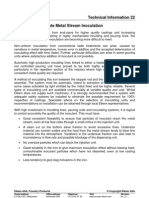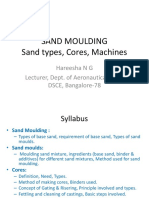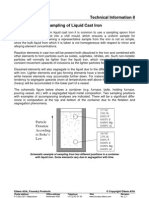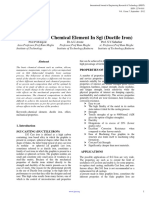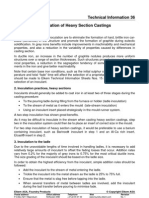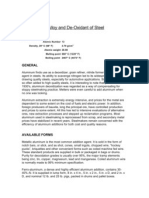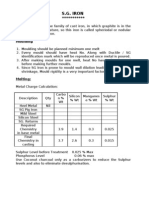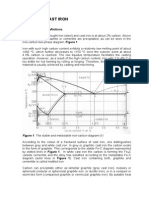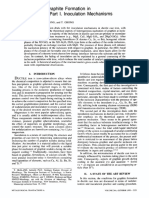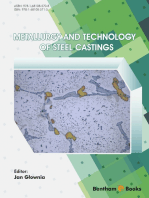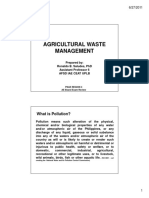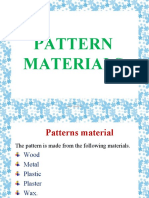0 ratings0% found this document useful (0 votes)
522 viewsSeminar S.G Iron
Seminar S.G Iron
Uploaded by
ravikataria02This document discusses the production of spheroidal graphite (SG) iron. SG iron, also known as ductile or nodular iron, has graphite present in the form of spheres rather than flakes, giving it improved ductility compared to grey cast iron. The key points are:
1. SG iron is produced by treating molten grey iron with magnesium or cerium to cause the graphite to form into spheres during solidification.
2. Proper chemical composition is important, with carbon content between 3-4% and silicon 1.8-2.8% promoting spheroid formation. Manganese should be below 0.5% to avoid carbides.
3. Properties of SG iron
Copyright:
© All Rights Reserved
Available Formats
Download as DOCX, PDF, TXT or read online from Scribd
Seminar S.G Iron
Seminar S.G Iron
Uploaded by
ravikataria020 ratings0% found this document useful (0 votes)
522 views32 pagesThis document discusses the production of spheroidal graphite (SG) iron. SG iron, also known as ductile or nodular iron, has graphite present in the form of spheres rather than flakes, giving it improved ductility compared to grey cast iron. The key points are:
1. SG iron is produced by treating molten grey iron with magnesium or cerium to cause the graphite to form into spheres during solidification.
2. Proper chemical composition is important, with carbon content between 3-4% and silicon 1.8-2.8% promoting spheroid formation. Manganese should be below 0.5% to avoid carbides.
3. Properties of SG iron
Original Description:
sg iron
Original Title
Seminar s.g Iron
Copyright
© © All Rights Reserved
Available Formats
DOCX, PDF, TXT or read online from Scribd
Share this document
Did you find this document useful?
Is this content inappropriate?
This document discusses the production of spheroidal graphite (SG) iron. SG iron, also known as ductile or nodular iron, has graphite present in the form of spheres rather than flakes, giving it improved ductility compared to grey cast iron. The key points are:
1. SG iron is produced by treating molten grey iron with magnesium or cerium to cause the graphite to form into spheres during solidification.
2. Proper chemical composition is important, with carbon content between 3-4% and silicon 1.8-2.8% promoting spheroid formation. Manganese should be below 0.5% to avoid carbides.
3. Properties of SG iron
Copyright:
© All Rights Reserved
Available Formats
Download as DOCX, PDF, TXT or read online from Scribd
Download as docx, pdf, or txt
0 ratings0% found this document useful (0 votes)
522 views32 pagesSeminar S.G Iron
Seminar S.G Iron
Uploaded by
ravikataria02This document discusses the production of spheroidal graphite (SG) iron. SG iron, also known as ductile or nodular iron, has graphite present in the form of spheres rather than flakes, giving it improved ductility compared to grey cast iron. The key points are:
1. SG iron is produced by treating molten grey iron with magnesium or cerium to cause the graphite to form into spheres during solidification.
2. Proper chemical composition is important, with carbon content between 3-4% and silicon 1.8-2.8% promoting spheroid formation. Manganese should be below 0.5% to avoid carbides.
3. Properties of SG iron
Copyright:
© All Rights Reserved
Available Formats
Download as DOCX, PDF, TXT or read online from Scribd
Download as docx, pdf, or txt
You are on page 1of 32
Seminar Report on Production of S.G. Iron Page No.
National Institute of Foundry & Forge Technology
1
1. INTRODUCTION
Spheroidal Graphite (S.G) Iron is the name given to that cast iron, where the graphite is
present in the matrix in the form of spheroid or globules or nodules. Hence it is also called as
Nodular Iron and because of its exceptionally high ductility (with elongation some times as high
as 22%) is also referred to as ductile iron.
The rapid growth of S.G iron and its high consumption are testimonials to its outstanding
mechanical properties. Heat treatments such as austempering have further enhanced its
properties. S.G iron is hence finding extensive application in number of the fields. After having
basically replaced a number of gray iron and malleable iron casting they have made
penetrating in roads, the forging industry such as crank shafts and cam shafts originally made
by the forging technology are now being cast in iron. S.G iron is produced by the treatment of
gray-iron with either cerium or magnesium. The more commercial of the two is magnesium and
is now almost universally used for production of S.G iron. Use of cerium is restricted as it is a
carbide forming element beyond 0.01%.
Seminar Report on Production of S.G. Iron Page No.
National Institute of Foundry & Forge Technology
2
2. LITERATURE SURVEY
2.1 HISTORY OF S.G IRON
The first announcement of successful production of Spheroidal Graphite structures in grey cast
irons was made by H.Morragh of British cast iron Research Association in the year 1948 at the
American Foundrymens societys Annual convention in Phladelphia, U.S.A.The process
involved a treatment of low sulphur hyper- eutectic cast iron with cerium, which was added as
mish metal shortly before casting. In same convention, T.M Wickenden of the International
Nickel Company, U.S.A disclosed that their researchers had also found out a method of
production of Spheroidal Graphite structure in the as cast condition by the introduction in the
iron, either hyper- eutectic, of a small but effective amount of magnesium or a magnesium
containing addition such as a nickel-magnesium alloy. Since then the latter process has been
found to be a commercially viable process and is now universally used for the production of
Spheroidal cast-iron.
The mechanism of graphite nodule formation however is still a matter of great controversy.
Various theories have been put forward by various researchers but none of them have gained
universal acceptance.
Basically S.G iron is produced by noduliging grey iron. Thus a melt of grey-iron is first of all
desulphurised. Desulphurization has to be invariably carried out and recarburization has to be
done if necessary. Once the base iron of required composition is ready, it is suitably treated for
spheroidization. Post-inoculations are then carried out if required and the melt is poured in to
the moulds as early as possible to avoid fading effect.
Seminar Report on Production of S.G. Iron Page No.
National Institute of Foundry & Forge Technology
3
2.2 DIFFERENT BETWEEN GREY IRON AND S.G IRON
Engineering application of cast iron have been traditionally based upon gray (flake
graphite) irons providing a range of tensile strengths between about 150N/mm
2
and 400N/mm
2
with recommended design stress in tensile application.
In contrast ductile irons have tensile strengths ranging from 350 to 1500N/mm
2
with
good elongation and high toughness. They now account for about 25% of iron casting
production serving in safety critical applications where they have replaced steel casting,
forging.
In short we can say that the highest mechanical properties of grey iron are the starting
points for S.G iron castings.
Gray Iron Structure S.G. Iron Structure
2.3 PRORERTIES OF S.G IRON
The S.G. family iron has several interesting properties. These are given below
High strength (in some cases even greater than steel)
Adequate ductility.
Superior castability.
Excellent machinability.
Lower density then that of steel.
Superior surface lubrication properties.
Better damping characteristics.
Seminar Report on Production of S.G. Iron Page No.
National Institute of Foundry & Forge Technology
4
3. PRODUCTION OF S.G. IRON
3.1 SLECTION OF CHEMICAL COMPOSITION
The choice of chemical composition in alloys started with the aim of obtaining a carbon-free as-
cast structure. The other factors that are considered are the effect of the various elements on
the shape and distribution of graphite and the structure of the matrix. All factors are further
affected by cooling rate.
CARBON: - It strongly promoted carbide free as cast structure. The carbon content for the
commercial ductile iron is form 3.0 to 4.0%, although much narrower limits are usually desired.
Nodule counts are directly affected by the carbon content greater number of spheroids
formation at the higher carbon contents. Increasing the carbon content also increases
castability by improving fluidity and feeding. The carbon content level should be co-related
with the carbon equivalent formula:-
CE = %C + 1/3 %Si + 1/3 %P
Carbon equivalents greatly is excess 4.3 promote the development and growth of graphite
spheroids. Since graphite is far less dense than molten iron these spheroids may be become
buoyant and float toward the cope surface of casting, resulting in gross carbon segregation,
floating, as this phenomenon is called is prevent in analyses having carbon equivalents greater
than 4.60 and in section sizes greater than 1inch.
SILICON:- It is a very strong promoter of carbide free as-cast structure. Apart from promoting
graphite and refining its distribution, silicon is the most potent beneficial element in increasing
strength and up to 4% will also increase as-cast ductility. Silicon being ferrite stabilizer,
increases hardness, particularly in the annealed condition. Silicon also influences the
distribution of graphite spheroids. The higher the silicon content, the higher the nodule count
and the more the ferrite content. However, higher silicon content is known to promote chunky
type graphite resulting in deterioration in properties of heavy ductile iron castings other
potentially objectionable influences of increasing silicon content are reduced impact energy,
increasing impact transition temperature and decreased thermal conductivity. The general
range for commercial production is specified at around 1.8% to 2.8%.
Seminar Report on Production of S.G. Iron Page No.
National Institute of Foundry & Forge Technology
5
Typical carbon and silicon range of S.G.Iron Casting
MANGANESE: - The only single aim in selection of the manganese percentage is to avoid as-
cast carbide. It must be preferably kept below 0.5%. A side benefit of lowered manganese
content is the lowering of the tendency of hydrogen pick- up and there by minimization of the
danger of pin hole. It must be noted that the manganese content must never be chosen with
the aim of controlling the matrix structure.
SULPHUR: - The control of sulphur for the production of the S.G iron is highly essential. If base
metal contains higher than 0.015% S are used in production of S.G iron, uneconomical
amounts of magnesium or other nodulizing agents would be required and problems such as
dross defect control get magnified. The base iron in-mould process should have sulphur
contents within the 0.01% range.
PHOSPHORUS: - Phosphorus decreases ductility, toughness and weldability and it is
detrimental to casting soundness. For these reasons most specifications tolerate a maximum of
0.03% only. It is however, a good practice to keep phosphorus content below 0.04%. In certain
cases where reduced creep rate, increased thermal conductivity and abrasion resistance are
required, the phosphorus content should be much more.
MAGNESIUM: - Magnesium is added for nodularization generally in the alloyed form. It has
been extensively reported in literature that the residual magnesium content in the S.G iron
formed should be between 0.02% to 0.06% while calculating the amount of magnesium
alloyed, required factors such as temperature of treatment, the efficiency of the treatment
process and the percentage of the magnesium in the alloy will have to be taken in to
consideration.
Seminar Report on Production of S.G. Iron Page No.
National Institute of Foundry & Forge Technology
6
Relationship between S and Mg in ductile iron
CARBON EQUIVALENT: - Selection of proper carbon equivalent depend to the great extent on
the section thickness of the casting produced. As the casting section increases the carbon
equivalent decreases. It varies from 4.2 for a section thickness of 80 to 100m.m to as high as 5
for a 3m.m section thickness.
Recommended carbon equivalent values for ductile iron castings of various thickness
Optimum pouring temperatures for different minimum section thickness
Seminar Report on Production of S.G. Iron Page No.
National Institute of Foundry & Forge Technology
7
3.2 ALLOYING ELEMENT AND THEIR EFFECTS
ELEMENT NORMAL
ADDITION
GENERAL EFFECTS OF ELEMENTS
COPPER 0.5 to 2.0 Strong pearlite promoter
Increases poof stress
Good tensile strength and hardness with no
embitterment
NICKEL 0.5 to 2.0 Mild pearlite promoter
Increases proof stress but little effect on
tensile strength
Danger of embitterment with larger addition
in excess of about 2 percent
TIN 0.05 to 0.1 Very strong pearlite promoter
Increases poof stress and hard ness but
danger of embitterment giving low tensile
strength elongation values
MOLYBDENUM 0.2 to 1.0 Mild pearlite promoter
Forms intercellular carbides especially in
heavy section
Increases poof stress and hardness
Danger of embitterment giving low tensile
strength and elongation
Improve elevated temperature properties
ARSENIC 0.05 to 0.1 Very strong pearlite promoter but not used
commercial possible , risk of embitterment
ANTIMONY 0.01 to 0.05 Very strong pearlite promoter but not used
commercial in S.G iron
CHROMIUM <0.1 Very strong carbide former. Should not be
employed if carbide-free structure is
required.
Seminar Report on Production of S.G. Iron Page No.
National Institute of Foundry & Forge Technology
8
3.3 SUBVERSIBLE ELEMENT AND ITS NEUTRALIZATION
The aim when production good quality ductile iron is to produce an iron having a fine
distribution of well formed nodules in the structure. The process of nodular graphite may reduce
mechanical properties, the reduction depending of nonnodular or flake graphite which may
present ISO 945 and ASTM 247 standard classify graphite according to a schematic
presentation of the observed structure and the ASTM standard contains enable control
personnel to assess graphite nodule number and size rapidly.
Small amount of element such as lead, bismuth, antimony and titanium singly or in combination
prevent magnesium having the desired modularizing effect and hence are often referred to as
subversive or interfering elements. The effects of subversive elements are cumulative. Small
amounts of two or more subversive elements present in amounts which individually have no
signification effect, together may adversely affected the formation of nodular graphite. The
subversive effect of some elements:-
Particularly titanium, lead and bismuth increasing as the size of the cast section increases. For
this reason acceptable levels can not be quoted and the effects of using furnace charge
materials controlling subversive elements can be evaluated by determination of the effect on
graphite structures in test bar or casting. When the elements are present individually,
subversive effects are likely to occur if the following levels are acceded lead 0.0005%, bismuth
0.002%, antimony 0.004 and titanium 0.1%.
The effect of subversible elements can be neutralized by the adding of a small amount of
cerium (0.002 to 0.005%) in addition to the magnesium.
Cerium contents above about 0.01% will results in a reduce nodule number and increasing risk
of carbide formation, so it is important not to add too much
3.4 MELTING PRACTICES
The relationship of melting practice to the type and amount of spheroiding alloy used is of
importance to casting and its physical properties
Seminar Report on Production of S.G. Iron Page No.
National Institute of Foundry & Forge Technology
9
Cupola melting is the most common methods of melting for melting for ductile iron, moreover
electrical induction furnace are in use in a number of foundries.
ACID CUPOLA MELTING:-Using acid cupolas necessitates close control over charge
materials and coke since the acid slag produced are not capable of reducing the sulpher
content of the iron. This result in sulpher contents of 0.06 to 0.12 present, which, if not lowered,
necessitates, the use of increasing amounts of spheroidizing alloy. Acid cupola melting,
however, is capable of controlling the readily oxidizable elements in the charge, such as
chromium and manganese. Since it is a more oxidizable process than the basic cupola
operation. Because of the moderate carbon pick up in acid base cupola melting and the desired
base iron chemistry , the use of pig iron of return is some what limited close composition
control and high metal temperatures, however can be produce without the need of a hot blast.
BASIC CUPOLA MELTING:- Basic cupola melting is characterized by the definite advantage
of sulpher control. Average sulpher content of the basic melt before spheradizing ranges from
0.025 to 0.035%. this decreased sulpher level in the melt is obtained at the expense of higher
operating cost , higher silicon losses during melting , less effective temperature and
composition control and a greater carbon pickup during melting.
ELECTRICAL MELTING:- Electrical melting has provided to be a clean and reliable melt. It
has also offered the greatest flexibility for melting irons of different grades.
Electrical arc furnaces have been found to be less popular than induction heated ones. Their
batch type operation and noise pollution have been the contributing factors. The facts that it
has found some application both as a primary melter and as a duplexer is mainly due to its time
prove reliability.
Electrical induction furnace have been the most common melting units for the production of S.G
iron , both in simplex operation in small foundries and as duplexing units. The coreless type is
being used for primary melting and a channel furnace is being used for duplexing .High
frequency units have been found to be good form the metallurgical point of view but are
associated with high costs. However, where furnace capacities under one tone are desirable
and speed of melting is a consideration, than the high frequency is to be preferable. The
coreless line frequency induction furnace has been found to be the best possible furnace for
melting of base iron for S.G. iron production. The low frequency ensures better stirring thus
resulting in homogenization melting.
Seminar Report on Production of S.G. Iron Page No.
National Institute of Foundry & Forge Technology
10
3.5 CHARGE MATERIALS
The average metallic charge for ductile base iron consists of pig iron, steel scrap, foundry
returns, ferrosilicon and other ferro alloys if necessary and carburizes if added with the charge.
Pig- iron has been found to be a significant contributor to the control of chemical composition.
The pig-iron for S.G iron production must be of a selective grade in view of very small amount
of sulpher and phosphorus present in sponge iron. There is trend to use sponge iron in place of
pig iron in S.G iron production.
3.6 POURING TEMPERATURE
Pouring temperature depends on the casting section. As the section thickness increasing, the
pouring temperature required decreases. For minimum section thickness up to 20 mm the
pouring temperature can be vary from 1350
0
c to 1480
0
c.
3.7 DESULPHURIHATION
Economical production of quality S.G iron can be take place only with consistently low sulphur
contents, with high sulphur content problem of dross defects gets magnified. The iron therefore,
must be thoroughly desulphurization before spheroidization treatment is carried out .Some of
the practical desulphurization agents are
Soda ash
Caustic soda
Burnt lime
Lime stone
Calcium carbide
A fine grained calcium carbide is desirable so as to present the greatest possible surface area
and the highest possible temperature has been found to be favorable for desulphurization .It
has also been known that the carbide must be kept in motion to present unreaceted carbide
surface to the dissolve sulfides. An addition of 1.5 to 2% calcium carbide has been reported to
have reduced a base sulphur content of 0.12% to 0.01%.
Soda ash has been used to bring down sulphur from 0.06% to 0.08% range. Further reduction
has not been possible by this compound. It was also found to cause environmental problems.
Various techniques have been evolved with the sole aim of effecting mixing and causing the
reaction between the molten metal and the desulphurization agents.
Seminar Report on Production of S.G. Iron Page No.
National Institute of Foundry & Forge Technology
11
3.8 NODULARIZING MATERIAL AND NODULARIZATION TECHNIQUES
With commercial and technical growth of S.G. Iron, there has been an evolutioan in the ranges
and character of nodularizing materials and methods unlike in the past the newer nodularizers
and processes lend to better control over process variables.
Nodularizing Materials.
Magnesium and the rare earths have been integral parts of S.G. iron production from its
earliest stages. As mentioned earlier, magnesium has, since than been found to be a
commercially viable nudularizer. However, to utilize the ability of cerium in neutralizing the
deleterious effects of subversive elements. Some alloys of magnesium used for nodularization
also contain small amounts of cerium.
Seminar Report on Production of S.G. Iron Page No.
National Institute of Foundry & Forge Technology
12
Basically two classes of nodularizers have evolved
(i) Elemental nodulizers where the magnesium is in unalloyed form.
(ii) Alloyed nudulizers in which the magnesium is alloyed with either silicon or nickel
with or without rare earths.
The magnesium content in the alloy in these alloys is an important factor. Numerous
investigators have demonstrated that as the magnesium content of the alloy decreases, the
magnesium recovery associated with in use increases. In Indian conditions, the 9% Mg-Fe-Si
alloy is reported to give good results. The magnesium recovery is also dependent on the
treatment temperature. Higher the treatment temperature, lesser will the magnesium recovery.
0.76 x (S% in base metal S% residual) + residual Mg%
Mg Recovery % =
Mg% added.
The amount of nodulizer required is given by the formula :
% nudulizer alloy =
E Mga
Mgs Mgr
% * %
% %
Where Mgr = residual magnesium
Mgs = The amount of magnesium that will reacts with sulpher
(% Mgs = 075 x % of sulphur in base Iron)
Mga = Magnesium in the alloy
E = Efficiency of the processes.
Problems associated with the addition of magnesium :
There are a number of inherent problems with the addition of magnesium and much of the
investigative work resulting to the production of ductile iron has been associated with ways and
means of over coming these problems.
1. Low Boiling Point Magnesium has a boiling point of about 1107
o
C which is lower than
the temperature of the molten cast iron being reacted. This pressure of magnesium at
the treatment temperature, prevent easy solution of magnesium and result in
considerable agitation and even violence during the reaction.
2. Low solubility - magnesium is only sparingly soluble in molten and solid cast iron, so
the use of alloys based on iron and magnesium is not possible.
3. Lower specific gravity The specific gravity of magnesium only 174 in comparison with
a value above 7 for cast iron. When added to cast iron, magnesium or its low density
Seminar Report on Production of S.G. Iron Page No.
National Institute of Foundry & Forge Technology
13
alloys tend to float giving rise to excessive losses caused by local boiling and
oxidation.
4. Fume As well as the fume and agitation associated with the addition of magnesium
or its alloys, excessive magnesium oxide fume is also formed. Although this is not toxic
it does result in a deterioration of working conditions in the found and is potential
problem unless adequate fume collection equipment is installed.
5. Dross formation During the treatment sulphides and oxides of magnesium are
formed which may remain suspended in the metal and subsequently lead to the
formulation of dross type defects in the casting. In addition, a magnesium oxides rich
skin is constantly being formed on the treated metal surface and this, in combination
with other oxides, results in the formation of refractory type complexes which can also
cause dross defect in castings.
Basic methods of overcoming the problem:
All the work carried out on improving the efficiency of the Mg treatment has been carried out
along with following lines:
1. To alloy the magnesium in order to increase the specific gravity and reduce the
tendency for the addition to float on the molten iron and control the rate of the action of
the Mg thereby reducing the reactions of violence and increasing recovery. Alloy
includes the classical nickel magnesium alloy containing 15% Mg, a range of Cu-Mg
alloys and also the ferrosilicon magnesium range which, are the most commonly used
materials for productions.
2. The magnesium alloy may be submerged, below the metal surface thereby eliminating
the floating effect. This enables alloys of high magnesium content to be employed
typical examples being Mg/Si containing 30-40% mg, magnesium impregnated coke
(42% Mg) and Mg sponge-Iron briquettes (15% Mg). Further advantages of this
practice may be achieved by increasing the depth of metal in the ladle. This gives
grater metal head which increases the time of passage through the molten Iron,
resulting in an increased Mg recovery.
3. Mg or Mg rich alloys may be impacted or dispersed into the molten Iron, which reduces
the reactions violence and provides an extended passage time for the Mg to react with
molten metal, pure Mg can be employed in this named
4. The pressure above the metal in the ladle can be in increased to a level exceeding the
vapour pressure of a magnesium at the temperature of treatment. This eliminates the
Seminar Report on Production of S.G. Iron Page No.
National Institute of Foundry & Forge Technology
14
boiling effect of magnesium and results on a quite reaction and good magnesium
recovery. Pure Mg is as used in such application.
5. Other methods have been devised where by the reaction rate and hence violence
associated with the addition of Mg is controlled, either in the mould itself or in a
specially designed vessel.
Techniques of Adding Magnesium to Molten Metal
In general the simple treatment methods can be satisfactory used with the more costly low
magnesium content alloys. Special purpose equipment enable cheaper, higher magnesium
content materials to be employed, but often introduces additional metal handling, maintenance
and control cost.
In Direct Pour On Technique :
This is the simplest technique of adding magnesium where by the metal is poured directly on
the weighed magnesium alloy. It requires no special equipment and conventional foundry
ladles can be used satisfactory. Temperature loss during treatment is also at a minimum, but
the technique can only be employed with the higher density alloys such as nickel magnesium,
copper magnesium and magnesium ferrosilicon to produce a magnesium recovery of about 25-
30%.
Since conventional foundry ladles are employed the technique can be readily applied to any
metal weight which can be of advantages in jobbing work where it is often impossible to
programme metal production to give a consistent metal demand.
IN DIRECT POUR ON TECHNIQUE
Seminar Report on Production of S.G. Iron Page No.
National Institute of Foundry & Forge Technology
15
SAND WHICH PROCESS:
The aim of this technique, which is basically an extension of the pour on methods is to produce
a higher magnesium recovery by holding down the magnesium alloy for a period of time and
also producing a localized low temperature area. The technique consists of building a pocket
into the bottom the Mg alloys and a cover of steel scrap (2-3%) of metal weight or a steel or
ductile iron plate. The metal stream from the furnace must be directed a way from the pocket to
obtain the maximum benefit the pocket should be deep enough to contain all of the alloy and
steel scrap and latter should be of small size in order to produce a high packing density. The
main disadvantages of metal temperature resulting from the scrap. The loss of about 0.1%
carbon due to the dilution effect of the steel scrap should also be borne in mind. The depth and
surface area of the formed cavity must be sufficient to contain the Mg alloy and steel scrap.
The metal stream is directed into the empty half of the ladle which then produces a smooth flow
of metal across the steel scrap, thereby precuenting premature reaction.
SAND WHICH PROCESS
COVER TRIGGER PROCESS :
This is a modification of the sandwich process, but instead of a steel cover a layer of an inert
materials such as calcium carbide is placed over the magnesium alloy. The ensure a uniform
layer of alloy it is advisable to employ the magnesium-ferrosilicon in the form of graded fines. It
is found that when metal is poured into the empty half of the ladle and subsequently flows over
the refractory bridge, the inert layer is not dislodge and reaction of magnesium does not
commences using this technique the ladle can be completely filled and if necessary transported
to suitable casting station before reaction is initiated. This has been carried out by
dislodgements of the calcium carbide or inert-cover crust and is accomplished by pricking with
a long diameter steel bar or alternatively, by the insertion of a graphite rod into the treatment
chamber before addition of the inert cover. In this instance, when the reaction is required to be
Seminar Report on Production of S.G. Iron Page No.
National Institute of Foundry & Forge Technology
16
started the graphite bar is nearly, twisted and removed from the chamber when reaction
commences.
If the correct of alloy fines and inert cover are employed a relatively quiet reaction results and
magnesium recoveries of the order of 50% can be achieved, even with the conventional
foundry ladle having a low height to diameter ratio. These benefits have to be offset by the
extra core required in adding the materials to the ladle, and the removal of the calcium carbide
rich slag, which is produced during treatment.
THE TUNDISH COVER :
Significant improvement in the treatment efficiency of the saved which process can be
achieved by the use of a suitably designed cover to the ladle, component with the simple open
laddle design, the tundish ever system offer greater consistency and increased magnesium
recovery together with significant reductions in fume and glare. The differences between
conventional ladle and tundish ladle operation are.
The tundish cover operates on the simple principle limiting the amount of air available for west
full combination with magnesium. Magnesium recovery is increased to between 60% and 65%
with accompanying cost savings.
Iron enters the ladle through a suitably sized hole in the tundish which forms an integral part of
the ladle cover. The entry hole is so positioned as to ensure that the first iron entering the ladle
is directed away from the treatment alloy. The diameter of the entry hole is designed to regulate
the iron flow and ensure that the tandish remains full throughout most of the magnesium
reaction there by limiting the in grass of air. Good sealing of the cover with the ladle and the
use of an overlapping opron are design features which improve the efficiency of the system.
Seminar Report on Production of S.G. Iron Page No.
National Institute of Foundry & Forge Technology
17
PLUNGING OR SUBMERGING TECHNIQUES
They are used with alloys of higher magnesium content (15 to 50%) which have low densities.
There are a number of operational factors to consider with these techniques especially position
of the holes in the plunger bell, and the ladle. Many variations in design of equipment are
possible but always the aim must be to maintain the alloy in the submerged position during the
entire treatment operation disadvantage of the techniques compared with the use of the simple
pour on methods are :
The higher metal temperature loss the need to treat a minimum of about 1 tonne of metal if
excessive temperature loss and low magnesium recoveries are to be avoided and the capital
plunger or other components of the system and more complex metal handling requirements.
The principal advantage is the ability to use the cheaper, higher magnesium content alloys
which may be silicon and aluminium free, to give magnesium recoveries typically of 40-60%.
G.F. CONVERTER PROCESS
The Gerge Fisher process has been the most successful of the treatment methods using pure
magnesium. The design of vessel is on the converter style and the metal is added when it is in
the horizontal position. After charging the metal the magnesium the hole formed in the side of
the ladle. This hole is than sealed and the converter is moved to the vertical position when
metal flows into the reaction chamber by using the correct number and diameter of the holes in
there factory partition plate the reaction is controlled and very high magnesium recoveries of
the order of 50-60% are readily achieved. The advantages of the techniques are the high
magnesium content the production irrespective of the base metal sulphur content and the use
of a silicon aluminum free treatment materials. The disadvantages are the capital of the
equipment and the need to treat a minimum of about 6 tons of the metal per hour.
Seminar Report on Production of S.G. Iron Page No.
National Institute of Foundry & Forge Technology
18
TREATMENT IN THE MOULD :
The technique of adding magnesium ferro-silicon in the mould cavity, now well known as the in
mould process. In this process not suitable for longer and relatively higher volume production of
ductile, the runner system for each casting contains a suitably designed chamber in which is
placed a weighed amount of magnesium alloy but development work is required to ensure that
consistency of structure can be assured on a production scale especially where multi-
impression cavities are involved. The metal flowing at a known rate over the treatment alloy,
produces a consistent pick-up of magnesium throughout the pouring period.
No smoke or fume comes out from the mould during the reaction period whilst excellent
magnesium recovery levels (usually >75%) are obtained. In addition there is no longer from
fading and the nucleating effect of the treatment alloy aviated the need for additional
inoculation.
Further more since no handling at magnesium containing iron is involved, problem with build
up of magnesium containing slags on ladle or furnace walls is eliminated.
Nevertheless, the technique requires low base iron sulpher levels (<0.015%), properly
designed running reaction system as a outlined above and also close control over the
treatment alloy if satisfactory structures and freedom form inclusions are to be achieved.
Adequate supervision or suitable monitoring systems are necessary to ensure that the addition
of the alloy has been made to each mould since each mould is in effect a separator treatment
the quality control systems adopted mg reflect this situation with possibly 100% checking being
required.
Seminar Report on Production of S.G. Iron Page No.
National Institute of Foundry & Forge Technology
19
Nodularing Alloy and Treatment Process
Treatment Process
1. Nickel Magnesium (5-15%Mg)
2. Copper Magnesium (10-15%Mg)
Pour on technique
1. Nickel silicon magnesium (15% Mg)
2. Copper silicon magnesium (12% Mg)
Sandwich technique
1. Magnesium Ferrosilicon (9%Mg)
2. Magnesium Ferrosilicon (5%Mg)
Sandwich and cover technique
1. Magnesium Ferrosilicon (5% Mg or 9%
Mg)
Tundish Cover
1. Magnesium Ferrosilicon (5% Mg ) In mould
1. Magnesium Ferrosilicon (3-6+%Mg) Flow through technique
1. Magnesium Silicon (20-35% Mg)
2. Magnesium impregnated coke (42%Mg)
3. Iron Magnesium briquettes (5-15% Mg)
Plunging or submerged
method technique
Magnesium bar (>99% Mg)
Magnesium powder (>99% Mg)
Pressure vessel, converter,
injection method
3.9 INOCULATION OF DUCTILE IRONS
PURPOSE:-The inoculation of cast iron involves the addition of small amounts of materials
(inoculant) to molten metal either just before or during pouring. Inoculation increases number of
points viable for the precipitation and subsequent growth of graphite. This effect of high level of
nucleation is demonstrated. High level of nucleation promoted graphite structure whilst low
levels can result in the formation of either mottled structure or white irons. The need for a high
level of nucleation increases as cooling rate increases i.e. section size decreases.
In addition to its effects on graphite morphology, magnesium is powerful carbide promoter;
there is a tendency for ductile irons to solidify with white or mottled structures. The primary
purpose of inoculating ductile irons, therefore is to suppress formation of chill and mottle. In
addition, inoculation is important in maintaining good nodule shape and also high nodule
numbers.
INOCULANTS USED:-Graphite is not an effective inoculant for ductile iron and all effective
inoculants are based on silicon. The most widely used is foundry grade ferrosilicon, contenting
Seminar Report on Production of S.G. Iron Page No.
National Institute of Foundry & Forge Technology
20
about 75% silicon. This alloy must contain small amount of aluminum and calcium, in order to
be fully effective the amounts required are about 1.5 to 2.05% aluminum and about 0.3 to 1.0%
calcium.
ADDITION OF INOCULANTS: In general, much larger of inoculants are used for ductile iron
than for grey irons with as much as 0.75% of silicon to be added as ferrosilicon. In practice, for
ladle inoculation a 0.5% silicon addition should be adequate for most purposes.
FADING: The effect of an inoculation addition is not permanent and starts to decreases (fade)
immediately after the addition of Mg is made. As fading occur the number of nodules
decreases, and the tendency to produce chill and mottle increases. In many cases half of the
inoculating effect is lost within the first five minutes and nearly all after 10 minutes. As fading
occurs graphite nodule shape deteriorates and quasi-flake or exploded nodules can be to occur
Different technique of inoculation
They are various technique of inoculation are
1. Ladle inoculation The selected grade of inoculant for ladle inoculation should
always be added to thermal stream when tapping from furnace to ladle, or ladle to
ladle. Additions should begin when the ladle is one-quarter full and be completed when
the ladle is three-quarters full, so that the last metal merely mixes.
It is therefore difficult to give an accurate estimate of the amount of inoculant which is
requiredfor every situation. In general inoculant addition of 0.3 to 1% by weight of
metal will be satisfactorily for S.G. Iron. Care must be taken not to over inoculate of
S.G. Iron there is problem arise with shrinkage porosity due to high nucleation level.
2. MOULD INOCULATION:-The starting point was the placing of a small amount of fine
ferrosilicon at the base of the sprue. However, results obtain tend to be erratic owing to
the tendency for the inoculants to be washed away by the initial stage of metal .as
development progressed the used of a bonded pellet or pre-cast.
Slug of inoculants was placed either in a chamber in the running system, or
top of the strainer are which was positioned at the bottom of the sprue. In either case it
was customary to provide a small mixing chamber before the metal entered the
casting.
Seminar Report on Production of S.G. Iron Page No.
National Institute of Foundry & Forge Technology
21
The weight of the inoculants placed in the mould varied in accordance with
weight of the casting and usually in the range 0.1 to 0.5% by weight of metal poured.
This means that the running system and feeder system to be taken in to account. it is
important that the inoculation is completely and uniformly distributed so that the effect
is uniformly through out the casting. How these are achieved will depend on the design
of the casting running and gating system. Mould inoculation can be used as the sole
method of inoculation but because of problem in ensure complete and uniformly
solution of the inoculation. It is more frequently used as a bake up to ladle inoculation.
Seminar Report on Production of S.G. Iron Page No.
National Institute of Foundry & Forge Technology
22
METAL STREM INOCULATION:- Most other forms of inoculation are based on the addition of
the powdered inoculants to the metal stream just above the pouring basin or bush. The
powdered inoculants (0.1 to 0.5 mm) are introduced via a tube to the metal stream. The
dispenser can be activated by means of a photoelectric cell or alternatively by the control
system fitted to an automatic pouring furnace. The delivery rate is set or the control box and
does not change significantly. The principle requirement is that the inoculants used should be
correctly sized and free from impurities which could give rise to slag inclusion.
Seminar Report on Production of S.G. Iron Page No.
National Institute of Foundry & Forge Technology
23
4. HEAT TREATMENT OF DUCTILE IRON
It is obviously desirable to achieve the required properties in the as-cast form, but this is not
always possible because of variations of section thickness etc. Heat treatment of the castings will
eliminate carbides in thin sections, produce more consistent matrix structures and for a given
structure, the mechanical properties are often improved by heat treatment, especially by
normalising. Where tempered martensite structures are needed, heat treatment is essential.
Stress relief
Heat at 50-100C/h to 600C (taking care not to exceed 610C), soak for one hour plus an hour for
every 25 mm of section thickness in the thickest section. Cool at 50-100C/h to 200C or less.
Ensure that the castings are adequately supported in the furnace so that they are not subjected
to stress.
Breakdown of carbides
Thin section castings may contain carbides in the as-cast structure, these can be eliminated by
soaking the castings at 900-925C for 3 to 5 hours.
Annealing to produce a ferritic matrix
Castings should be soaked at 900-925C for 3-5 hours, followed by slow cooling at around 20-
35C/h through the critical temperature (about 800-710C), then furnace cooled at, say 50-
100C/h to 200C
Normalising to produce a pearlitic matrix
Soak the castings above the critical temperature then air cool. Again a soaking temperature of 900-
925C is usually used, to ensure that carbides are broken down, then use forced air cooling to form
pearlite. The type of heat treatment "unace available and the size of the load determines the cycle
that is possible. it may be necessary to adjust the metal composition with tin or copper to help
the formation of fully pearlitic structures.
Hardened and tempered structures
Austenirise at 900-920C then oil quench. Tempering is usually carried out 600-650C.
Seminar Report on Production of S.G. Iron Page No.
National Institute of Foundry & Forge Technology
24
Austempered ductile iron (ADI)
Austempering is an isothermal heat treatment for producing 'bainitic' structures. It can double the
strength of ductile iron while retaining good ductility and toughness. Wear resistance and fatigue
properties are excellent so that ADI is comparable with wrought steel.
The ADI heat treatment is a two-stage process, shown in the graph. Austenitising is carried out at
815-930C to fully transform the matrix to austenite. This is done either in a non-oxidising
atmosphere furnace or in a high temperature salt bath, temperatures and times are determined
by chemical composition, section size and grade of ADI required. 1 to 1.5 hours is usually adequate.
Slow initial heating of the casting is desirable to avoid the danger of cracking of complex shapes.
The castings are then quenched to the required isothermal heat treatment temperature, usually
between 210 and 400C This is usually done in a salt bath. The castings are held at temperature for
1-2 hours to complete the transformation of austenite to bainite. The lower temperatures give high
hardness, strength and wear resistance, while the higher heat treatment temperatures result in
higher ductility and toughness. After the isothermal treatment, the castings are cooled to
ambient temperature
Typical austempering heat-treatment stages.
Seminar Report on Production of S.G. Iron Page No.
National Institute of Foundry & Forge Technology
25
5. MECHANICAL PROPERTIES & MICROSTRUCTURE OF S.G. IRON
5.1 MECHANICAL PROPERTIES
BS-2789:1985 GRADES OF S.G IRON AND THEIR MECHANICAL PROPERTIES:
Propery
Grade Produce to BS-2789:1985
350/
22
400/
18
420/
12
450/
10
500/
7
600/
3
As-cast or
normalized
Quenched and
tempered martensite
700/2 800/2 900/2 700/2 800/2 900/2
Tensile strength
N/mm
2
350 400 420 450 500 600 700 800 900 700 800 900
Elongation%
(minimum and
range)
22
to
29
18
to
27
12
to
20
10
To
18
7
To
15
3
To
7
2
To
5
2
To
5
2
To
5
2
To
5
2
To
5
2
To
5
0.1% Poof strength(N/mm
2
)
1.Tension 203 248 266 293 323 346 385 440 495 525 600 675
2.Compression 226 271 289 316 340 360 397 452 507 537 612 687
3.Torosion 157 192 206 227 241 247 270 308 347 368 420 473
1.Typical impact
properties un-notch
fully ductile
108
To
149
108
To
149
108
To
149
95
To
140
85
To
120
40
To
75
27
To
40
25
To
35
25
To
35
108
To
149
108
To
149
108
To
149
2. Notched fully
dutile (J)
18
to
21
16
to
19
16
to
19
9
to
16
7
to
16
7
to
11
6
to
8
6
to
8
6
to
8
6
to
8
6
to
8
6
to
8
Ductile to Brittle
Transition
o
C
(Mean notch
values)
-50
to
-10
-50
to
-10
-50
to
-10
0
to
20
20
to
60
40
to
80
60
to
80
60
to
80
60
to
80
0
to
40
0
to
40
0
to
40
Hardness HB
10/3000 Range
107
to
130
130
to
140
140
to
155
155
to
172
172
to
216
216
to
247
247
to
265
265
to
282
282
to
299
232
to
259
259
to
286
286
to
313
Recommended design Stress
Tensile (Static)
N/mm
2
114 139 140 154 155 161 173 138 223 236 270 304
Corpression (Static)
N/mm
2
136 163 173 190 204 216 239 272 305 323 368 413
Alternative fatigue
Un notched 60 65 67 70 75 83 93 101 106 93 101 106
Notched 38 40 41 43 45 50 56 61 63 56 61 63
Seminar Report on Production of S.G. Iron Page No.
National Institute of Foundry & Forge Technology
26
Mechanical properties and their chemical composition of some casting
(produced by L&T)
1. Mechanical Properties
Yield strength. 302.39MPa
U.T.S. 420.77MPa
% Of elongation. 20.57
Impact strength. 8 J
The impact strength is measured at 20
o
C.
Microstructure as-cast condition
100X
The metal composition of this casting:-
Composition Percentage
C 3.63
Si 2.15
Mn 0.17
S 0.008
P 0.029
Cr 0.3
Ni 0.36
Cu 0.02
Mg 0.043
2. Mechanical properties
0.2% Proof stress. 261MPa
U.T.S. 369MPa
% Of elongation. 22.28
Impact strength. 14,13,16 J
Microstructure of as-cast conditions
100X
Seminar Report on Production of S.G. Iron Page No.
National Institute of Foundry & Forge Technology
27
The metal composition of this casting:-
Composition Percentage
C 3.6
Si 2.67
Mn 0.19
S 0.01
P 0.031
Cr 0.03
Ni 0.39
Cu 0.007
Mg 0.067
COMPOSITIONS some SG Iron casting (Produced by L&T)
SL.NO. C Si Mn S P Cr Ni Mo Cu Mg
1 3.63 2.15 0.17 0.008 .029 0.03 0.36 0.002 0.02 0.043
2 3.68 2.55 0.15 0.01 0.03 0.039 0.33 0.005 0.028 0.038
3 3.55 2.19 0.18 0.01 0.026 0.02 0.36 0.001 0.011 0.045
4 3.58 2.05 0.2 0.011 0.036 0.02 0.42 0.002 0.002 0.037
5 3.54 1.8 0.2 0.01 0.031 0.03 0.31 0.00 0.009 0.04
Mechanical Properties of the ITEMS:-
SL.NO Test
condition
0.2%proof
stress (Mpa)
U.T.S.
(Mpa)
% Of
elongation
Impact (J)
At 20
o
C
1 Not heat treated * 420.77 20.57 8 8 8
2 Not heat treated 270.56 382.00 23.14 16 17 17
3 Not heat treated 238.97 382.00 22.28 17 16 17
4 Not heat treated 302.07 481.08 17.28 6 6 5
5 Not heat treated 270.56 391.47 23.14 17 15 15
Seminar Report on Production of S.G. Iron Page No.
National Institute of Foundry & Forge Technology
28
5.2 MICROSTRUCTURE OF SG IRON
Microstructure of nodular iron with 4.13% silicon content
Microstructure of nodular iron with 0.50%
phosphorus content
Microstructure of nodular iron with 2.92% Mn content
Nodular iron prepared from Swedish charcoal iron
with no special addition other than magnesium and
inoculant
Small amount of flake form of graphite due to 0.009%
lead.
0.13% cerium. Graphite nodules in a matrix of
pearlite.
Flake from of graphite in iron No. 4 with 0.013% lead
0.003% basimuth.
Seminar Report on Production of S.G. Iron Page No.
National Institute of Foundry & Forge Technology
29
0.004% antimony.
0.022% antimony and 0.15% cerium.
0.022% antimony and 0.028% cerium.
0.016% tin.
0.13% aluminum
Iron no. 53 with 0.34% aluminum.
0.02% titanium.
0.03% titanium.
1.2 in. diameter bar with 0.075% magnesium.
1.2 in. diameter bar with 0.117% magnesium
Seminar Report on Production of S.G. Iron Page No.
National Institute of Foundry & Forge Technology
30
6. APPLICATION OF S.G IRON
The application of the S.G iron have increased tremendously in recent times as can be seen
from the list of the components which are being made.
Engine crank shaft
Brake caliper, disc brake anchor, brake anchor plate.
Machine- tool bed
Electrical insulator post and cap.
Steering Knuckle
Rack and pinion of steering assembly
Piston for impact drills.
Rolling mill rolls.
Moulding boxes and mould box clamps
Brake shoe for heavy duty brakes.
Glass moulds.
Spacer cage for rolling bearing.
Piston rings.
Wind mill items.
Seminar Report on Production of S.G. Iron Page No.
National Institute of Foundry & Forge Technology
31
7. CONCLUSIONS
The ductile iron finds wide engineering application because of its excellent combination of
castability and mechanical property. It has also very good machaniability, corrosion resistance,
wear resistance and thermal shock resistance. It finds application in gears, dies, valve and
pump bodies, pinion, crank shaft etc. It is a widely acceptable cast iron because of high
strength and good ductility. The problems faced due to lower melting and boiling point of Mg
have been encounter by using various magnesium treatment practices.
Seminar Report on Production of S.G. Iron Page No.
National Institute of Foundry & Forge Technology
32
REFERENCES
1. Source book on Ductile Iron, ASM Publication, June 1977.
2. AFS Production of S.G. Iron Practice, 1976.
3. Fosico-ferrous Foundrymen, Handbook by R. Brown, 2000.
4. Principles of Metal Casting by Philip C. Rosenthal, 2003
5. ASM Hand Book, vol.15 (Casting), Ninth Edition, September, 1988.
6. Ductile Iron Production practice by BRCA, 1995.
7. Foundry Technology Paul J. Mikelonis ASM and AFS, 1985.
8. Typical Microstructures of cast metal, by G. Lambert, 1966
You might also like
- Technical InformationDocument78 pagesTechnical InformationCarlos Barrachina Martínez100% (3)
- Diagramas Elect Isuzu 2002Document153 pagesDiagramas Elect Isuzu 2002ALTA MECANICA DIESEL DEL SUR100% (1)
- ELMAGDocument2 pagesELMAGthomazfabricioNo ratings yet
- Common Metallurgical Defects in Ductile Cast IronDocument10 pagesCommon Metallurgical Defects in Ductile Cast IronsateeshkoriNo ratings yet
- Versatility of Cored Wire Process For Producing Ductile IronDocument10 pagesVersatility of Cored Wire Process For Producing Ductile IronDNo ratings yet
- GAS PROBLEM in Steel Sand CastingsDocument7 pagesGAS PROBLEM in Steel Sand CastingsVasu RajaNo ratings yet
- Ductile Dross Formation MonitoringDocument27 pagesDuctile Dross Formation MonitoringsachinguptachdNo ratings yet
- 1996 Bombay Foundry Congress - Inoculation of Grey and Ductile Iron PDFDocument23 pages1996 Bombay Foundry Congress - Inoculation of Grey and Ductile Iron PDFhabibi1328100% (1)
- S.G IronDocument6 pagesS.G IronQasim BarkatNo ratings yet
- SG Iron CompositionDocument5 pagesSG Iron CompositionamirgukharNo ratings yet
- SG Iron ProductionDocument20 pagesSG Iron ProductionShreyashri Nayak100% (1)
- Chunky GraphiteDocument16 pagesChunky GraphitesachinguptachdNo ratings yet
- Selection of Inoculants For Ductile Cast IronDocument1 pageSelection of Inoculants For Ductile Cast Ironarnaldorcr8646100% (1)
- Inoculation Mechanisms - Part Two - KEY To METALS ArticleDocument3 pagesInoculation Mechanisms - Part Two - KEY To METALS Articlekumarpankaj030No ratings yet
- 6-CC 2011-India-Mg-recoverDocument21 pages6-CC 2011-India-Mg-recovercrazy dNo ratings yet
- Elkem InoculacaoDocument26 pagesElkem Inoculacaoeduardolavrati100% (1)
- ATAS Metstar Kovis FoundryDocument18 pagesATAS Metstar Kovis Foundryslagmercury100% (1)
- Recovery of Magnesium in A Ductile Iron Process.: AbstractDocument8 pagesRecovery of Magnesium in A Ductile Iron Process.: AbstractJorge Prado DiazNo ratings yet
- Partition of Slag Phases in The Treatment and Pouring of Ductile IronDocument2 pagesPartition of Slag Phases in The Treatment and Pouring of Ductile Ironarnaldorcr8646No ratings yet
- Late Metal Stream InoculationDocument2 pagesLate Metal Stream Inoculationarnaldorcr8646No ratings yet
- Home About Us Products Quality Control Representation Useful Links Contact UsDocument5 pagesHome About Us Products Quality Control Representation Useful Links Contact Ustushak mNo ratings yet
- Carbide Dissolution in Thin Wall Ductile Iron PDFDocument8 pagesCarbide Dissolution in Thin Wall Ductile Iron PDFsachinguptachdNo ratings yet
- Study of Pinholes Genesis in Iron Castings: Archives of Foundry EngineeringDocument6 pagesStudy of Pinholes Genesis in Iron Castings: Archives of Foundry EngineeringFabiano MonteiroNo ratings yet
- Sand Moulding Sand Types, Cores, Machines: Hareesha N G Lecturer, Dept. of Aeronautical Engg, DSCE, Bangalore-78Document50 pagesSand Moulding Sand Types, Cores, Machines: Hareesha N G Lecturer, Dept. of Aeronautical Engg, DSCE, Bangalore-78upender100% (1)
- Sampling of Liquid Cast IronDocument2 pagesSampling of Liquid Cast Ironarnaldorcr8646No ratings yet
- Effect of Basic Chemical Element in Sgi Ductile Iron IJERTV1IS7135Document7 pagesEffect of Basic Chemical Element in Sgi Ductile Iron IJERTV1IS7135Uma KoduriNo ratings yet
- 3 Inoculant Alloy CompositionDocument2 pages3 Inoculant Alloy CompositionAdams GodoyNo ratings yet
- Selection of Inoculants For Grey Cast IronDocument2 pagesSelection of Inoculants For Grey Cast Ironarnaldorcr8646100% (1)
- Elkem 07 Magnesiun Contents in Ductile IronDocument2 pagesElkem 07 Magnesiun Contents in Ductile Ironmarcotulio123No ratings yet
- De-Oxidising SteelDocument19 pagesDe-Oxidising SteelJeyakumarNo ratings yet
- Effect of Minor and Trace Elements in Cast IronDocument2 pagesEffect of Minor and Trace Elements in Cast IronsachinguptachdNo ratings yet
- Inoculation of Heavy Section CastingsDocument2 pagesInoculation of Heavy Section Castingsarnaldorcr8646100% (1)
- Analysis of Quality and Cost of FeSiMg Treatment Master Alloy vs. Cored Wire in Production of Ductile Cast IronDocument4 pagesAnalysis of Quality and Cost of FeSiMg Treatment Master Alloy vs. Cored Wire in Production of Ductile Cast IronAdams GodoyNo ratings yet
- Elkem 10 Tundish Cover Ladle NodularizationDocument2 pagesElkem 10 Tundish Cover Ladle Nodularizationmarcotulio123No ratings yet
- Common Metallurgical Defects in Grey Cast IronDocument9 pagesCommon Metallurgical Defects in Grey Cast IronRolando Nuñez Monrroy100% (1)
- Effect of Boron in D.I.Document2 pagesEffect of Boron in D.I.Sachin KumbharNo ratings yet
- Aluminum As Alloy and DeoxidantDocument5 pagesAluminum As Alloy and DeoxidantlarryjhNo ratings yet
- Elkem - Overview Brochure Foundry TabletDocument6 pagesElkem - Overview Brochure Foundry TabletHassan Ahmed100% (1)
- Lecture 7 Inclusions and Pinhole Formation in DIDocument33 pagesLecture 7 Inclusions and Pinhole Formation in DILuis Arturo RamirezNo ratings yet
- Selection of NodularizersDocument2 pagesSelection of Nodularizersarnaldorcr8646100% (2)
- Surface Graphite Degeneration in Ductile Iron CastDocument8 pagesSurface Graphite Degeneration in Ductile Iron CastKhairul MuzafarNo ratings yet
- Effective Filtration of Steel CastingsDocument40 pagesEffective Filtration of Steel CastingsWalter Hartwell WhiteNo ratings yet
- S.G. Iron : MouldingDocument11 pagesS.G. Iron : MouldingsureshbabuamalaNo ratings yet
- Seminar Report On Cast IronDocument48 pagesSeminar Report On Cast IronPulkit bajaj100% (3)
- Investment Casting of Ductile IronsDocument5 pagesInvestment Casting of Ductile IronsSteve GreenNo ratings yet
- Niobium in Cast IronDocument13 pagesNiobium in Cast IronTayyab HussainNo ratings yet
- Elkem 06 Fading of InoculationDocument2 pagesElkem 06 Fading of Inoculationmarcotulio123No ratings yet
- Alternative Tundish Ladle DesignDocument2 pagesAlternative Tundish Ladle Designarnaldorcr8646100% (1)
- A Model For The Graphite Formation in Ductile Cast Iron Part I Inoculation MechanismsDocument25 pagesA Model For The Graphite Formation in Ductile Cast Iron Part I Inoculation MechanismsAdams GodoyNo ratings yet
- Foundry DefectsDocument12 pagesFoundry DefectsVirendra Gupta100% (2)
- Fe Si MGDocument30 pagesFe Si MGamitkkambleNo ratings yet
- Steel Pouring TimesDocument2 pagesSteel Pouring Timesvasanthi100% (1)
- Topic 4: Classification, Properties and Applications of S.G. and C.G.Iron S.G.IRONDocument11 pagesTopic 4: Classification, Properties and Applications of S.G. and C.G.Iron S.G.IRONsandeep kumarNo ratings yet
- Vermicular GraphiteDocument12 pagesVermicular GraphiteUyên QuáchNo ratings yet
- Iron CastingDocument23 pagesIron CastingDiego MoralesNo ratings yet
- Cast Iron PropertiesDocument8 pagesCast Iron PropertiesGerardo JM Palacios100% (1)
- Grey Iron A Unique MaterialDocument13 pagesGrey Iron A Unique MaterialmetkarthikNo ratings yet
- Graphite Degeneration in The Superficial Layer ofDocument11 pagesGraphite Degeneration in The Superficial Layer ofBehdad ShariatiNo ratings yet
- Chapter 5 - SteelmakingDocument62 pagesChapter 5 - SteelmakingGRAHAM KUNDAI DENGEZANo ratings yet
- PSAE review-AWMS PDFDocument37 pagesPSAE review-AWMS PDFCynthia B.GayumbaNo ratings yet
- Komus 2017Document19 pagesKomus 2017John Robert Dizon GabrielNo ratings yet
- 14 Failure of Cutting Tools and Tool LifeDocument11 pages14 Failure of Cutting Tools and Tool LifePRASAD326100% (8)
- Mock Drill Oil Bottling Plant - BangaloreDocument34 pagesMock Drill Oil Bottling Plant - Bangaloresaquib_jamadarNo ratings yet
- GeoMatt Datasheet TB11 Ed1 2017 ASTM ADDocument1 pageGeoMatt Datasheet TB11 Ed1 2017 ASTM ADganmosesNo ratings yet
- Hazardous Area ClassificationDocument36 pagesHazardous Area Classificationvenkeeku100% (2)
- Light Pole FoundationDocument1 pageLight Pole FoundationMalik Imran Shakir100% (2)
- Building Design 2 Final Examination: Load ScheduleDocument1 pageBuilding Design 2 Final Examination: Load ScheduleKent Aldwin MangalinoNo ratings yet
- STORAGE: Aerating Stored GrainDocument4 pagesSTORAGE: Aerating Stored GrainMilling and Grain magazineNo ratings yet
- IGBC Question PaperDocument17 pagesIGBC Question PaperAnkitaBansalNo ratings yet
- JacketIngDocument28 pagesJacketIngVelmurugan Balasubramanian0% (1)
- Accomplishment in Waste SegregationDocument6 pagesAccomplishment in Waste SegregationJaime Daileg100% (3)
- 11169_2_2023Document28 pages11169_2_2023Shaheen MaveNo ratings yet
- Instrument Testing ProcedureDocument13 pagesInstrument Testing ProcedureDaengkulle Firmansyah PuteraNo ratings yet
- Non Biological Sawage, Waste Water Treatment System VS, Conventional STPDocument26 pagesNon Biological Sawage, Waste Water Treatment System VS, Conventional STPArnel AlvarezNo ratings yet
- Garments Construction Standards Contents 目录 Section 1: - Components and trimsDocument38 pagesGarments Construction Standards Contents 目录 Section 1: - Components and trimsbeeyesyem100% (1)
- Modelo de Condensadora Puhy-P1200tkaDocument6 pagesModelo de Condensadora Puhy-P1200tkaBrandon Antonio Peralta LópezNo ratings yet
- LPT Article 6Document5 pagesLPT Article 6Ashfaq KhanNo ratings yet
- Dimensiuni EpruveteDocument3 pagesDimensiuni Epruvetedorindorin2No ratings yet
- Paraliq P 150Document1 pageParaliq P 150David LieNo ratings yet
- East/west Finish CodesDocument14 pagesEast/west Finish CodesEastWest IndustriesNo ratings yet
- Energy BalanceDocument38 pagesEnergy Balancebelkiza menalla0% (1)
- Asian Paints Professional Economy Texture DesignsDocument2 pagesAsian Paints Professional Economy Texture DesignsBestin JoseNo ratings yet
- Republic of The Philippines Municipality of IPIL Barangay:MaasinDocument91 pagesRepublic of The Philippines Municipality of IPIL Barangay:MaasinAljie CañeteNo ratings yet
- Pattern MaterialsDocument16 pagesPattern MaterialsMani Kandan100% (1)
- QA450Document126 pagesQA450Аленка Дерзкова100% (2)
- Vertical Retort Pit FurnaceDocument2 pagesVertical Retort Pit FurnaceskluxNo ratings yet
- DC Protection Relay PrinciplesDocument28 pagesDC Protection Relay Principlesrvim0002100% (1)
- Geologia Econômica KupferschieferDocument2 pagesGeologia Econômica KupferschieferDavid QMNo ratings yet



















